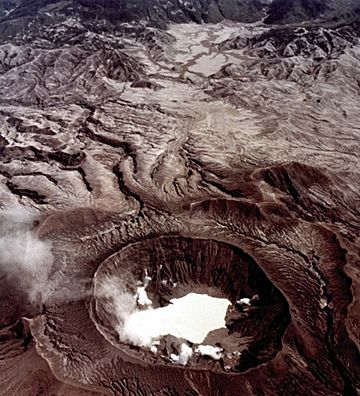El Chichón facts for kids
Quick facts for kids El Chichón |
|
|---|---|

Aerial view on 4 November 1982, seven months after the eruption
|
|
| Highest point | |
| Elevation | ~ 1,205 metres (3,953 ft) |
| Geography | |
| Geology | |
| Age of rock | 220,000 yr |
| Mountain type | Lava domes |
| Volcanic arc/belt | Chiapanecan Volcanic Arc |
| Last eruption | March to September 1982 |
El Chichón, also known as Chichonal, is an active volcano in Francisco León, Mexico. It is located in the north-western part of Chiapas state. El Chichón is part of a group of volcanoes called the Chiapanecan Volcanic Arc.
This volcano is made up of several lava domes and a tuff ring. A tuff ring is a low, wide ring of volcanic ash and rock. El Chichón sits between two larger volcanic areas: the Trans-Mexican Volcanic Belt and the Central America Volcanic Arc.
El Chichón became very well known for its eruption in 1982. Before that, it had not erupted since around 1360. Some people think there might have been an eruption around 1850, but this is still debated.
The 1982 eruption was a big event. In less than a week, this volcano, which was thought to be sleeping, had three huge eruptions. These eruptions happened on March 29, April 3, and April 4. They sent a lot of sulfur dioxide gas and tiny particles into the air.
Even though the 1982 eruption was smaller than the famous Pinatubo eruption in 1991, its effects on the world's climate were just as important. El Chichón's eruption teaches us a lot about preparing for volcanic disasters. It also shows how much volcanoes can change our climate.
The 1982 Eruption
The 1982 eruption of El Chichón was the biggest disaster in modern Mexican history. The powerful explosions sent out high-sulfur magma. This magma also contained a mineral called anhydrite. The eruptions destroyed the top of the volcano and its lava dome.
Hot pyroclastic flows and surges rushed down the volcano's sides. These destroyed an area about 8 kilometers (5 miles) around the volcano. Nine villages were completely wiped out, and about 1,900 people lost their lives.
A new crater, about 1 kilometer (0.6 miles) wide and 300 meters (980 feet) deep, was formed. This new crater now holds an acidic crater lake. The land around the volcano was covered in ash up to 40 centimeters (16 inches) deep.
Over 24,000 square kilometers (9,300 sq mi) of countryside were affected. This ruined coffee, cocoa, and banana crops, as well as cattle farms. The eruption also created natural dams in the Rio Magdalena river. These dams later broke, causing mudslides called lahars. The lahars destroyed important buildings and roads. The total damage from the 1982 eruption was about $55 million. Today, that would be about $132 million.
Why People Weren't Ready
It had been more than 600 years since El Chichón's last big eruption. Because of this, very few people knew about the danger. Most people thought the volcano was either sleeping (dormant) or completely extinct.
In 1980 and 1981, earthquakes were felt in the areas around the volcano. Geologists made maps showing the risks. However, there was no increase in monitoring the volcano's activity. This meant people were not prepared for what was coming.
How the Eruption Affected Climate
The 1982 eruption was a VEI-5 event. This means it was a very large explosion. It shot 7 million metric tons of sulfur dioxide and 20 million metric tons of other particles into the stratosphere. The stratosphere is a high layer of Earth's atmosphere. These materials circled the Earth in just three weeks. The amount of sulfur dioxide was similar to the 1991 eruption of Mount Pinatubo.
The eruption happened just as the 1982–83 El Niño event was starting. Some scientists thought El Chichón caused the El Niño. However, studies have shown that these two events were just a coincidence. There is no real connection between them.
Because the eruption and El Niño happened at the same time, the climate felt effects from both. This made it hard to tell their impacts apart. Usually, a volcanic eruption causes the Earth to cool down, especially in summer. But after El Chichón, there was no cooling in the first year. This was because the El Niño caused a lot of warming that balanced out the cooling.
The climate changes also led to warmer winters in some parts of the Northern Hemisphere in 1982 and 1983. Temperatures went up in North America, Europe, and Siberia. But during the same winter, Alaska, Greenland, the Middle East, and China had colder temperatures than normal. This shows that the effects were different in various regions. These differences are thought to be caused by volcanic aerosols changing how winds move in the atmosphere. This includes something called the Arctic Oscillation.
See also
 In Spanish: El Chichón para niños
In Spanish: El Chichón para niños
- List of volcanoes in Mexico


